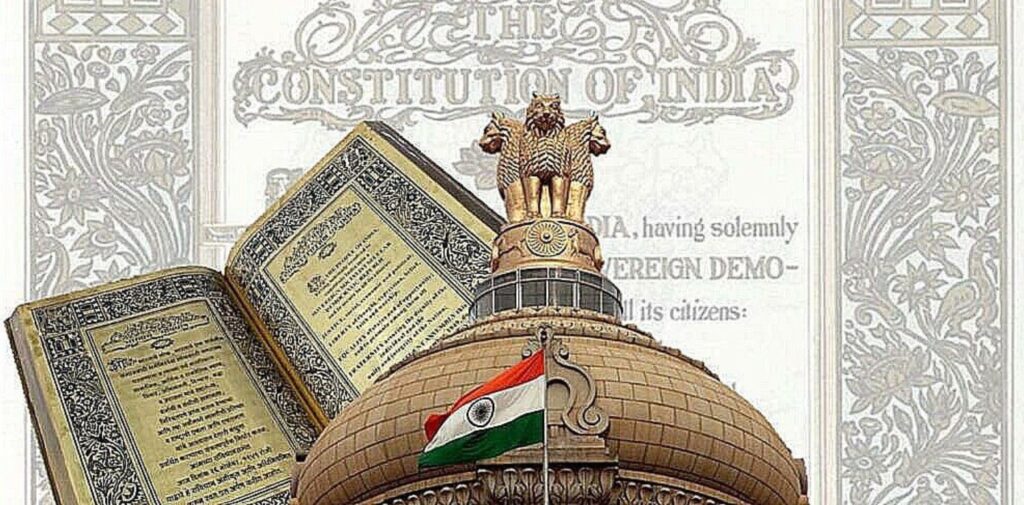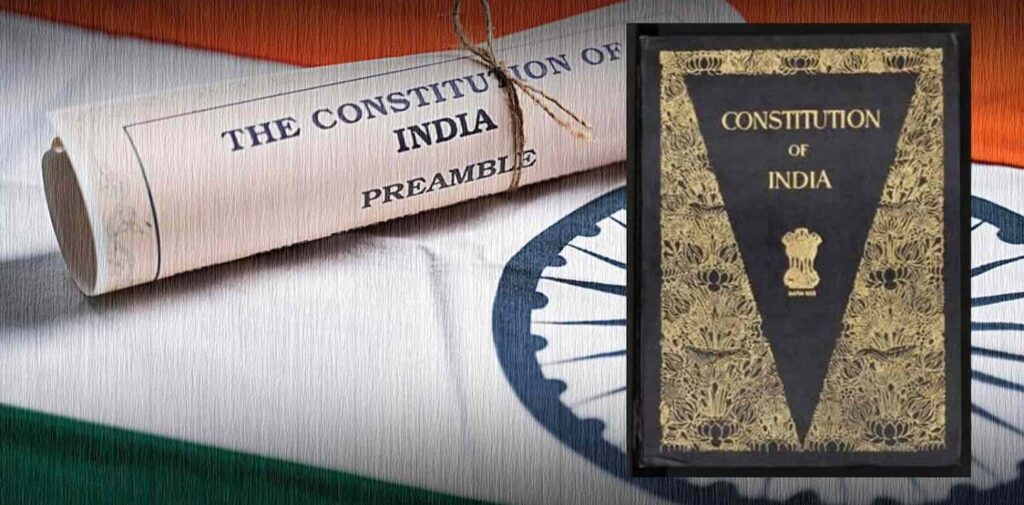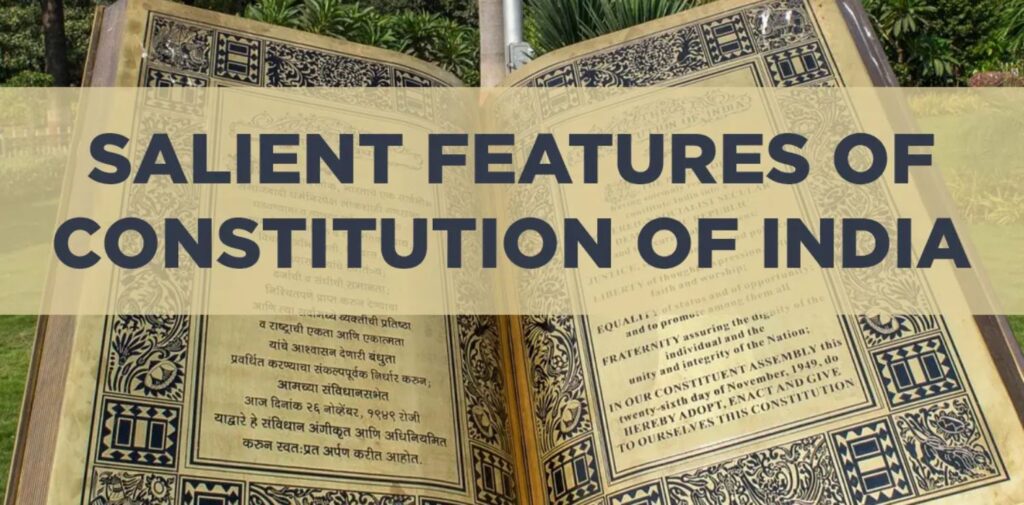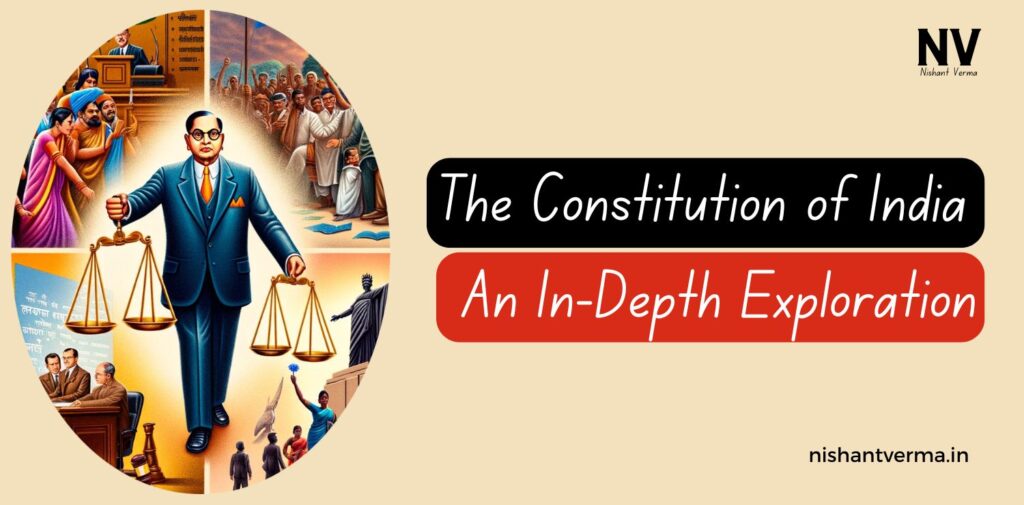The Constitution of India is not just a legal document; it is the cornerstone of Indian democracy and governance. It defines the framework for the political system, the distribution of powers, and the rights of citizens. This article will cover the history of the Constitution, its acceptance and implementation, its structure, the number of parts, and the significance of its provisions.
Historical Background
Acceptance and Coming into Force
The Constitution of India was accepted on 26th November 1949 by the Constituent Assembly after extensive deliberations. This day is commemorated as Constitution Day (Samvidhan Divas) in India. The Constitution officially came into force on 26th January 1950, a date chosen to honour the declaration of Independence made on January 26, 1930, during the Indian freedom struggle. This marked India’s transformation into a sovereign republic, signifying that the country was now governed by its Constitution rather than colonial laws.
First President of the Constituent Assembly
The Constituent Assembly, which drafted the Constitution, was presided over by Dr Sachidanand Sinha, who served as its first President. Later, Dr. B.R. Ambedkar became the chief architect of the Constitution and was appointed as the Chairman of the Drafting Committee. His vision and contributions were instrumental in shaping the Constitution, ensuring that it reflected the aspirations of a diverse nation.

Structure of the Constitution
The Constitution of India is a comprehensive document comprising 25 parts, which systematically cover various aspects of governance, rights, and duties. Here’s a detailed breakdown of each part:
Part I: The Union and its Territory
This part defines the territory of India and the formation of new states. It consists of articles that outline how states and territories can be created or reorganized.
Part II: Citizenship
It addresses who is a citizen of India and the rules governing the acquisition and termination of citizenship. This part ensures that all citizens have the right to live freely in the country.
Part III: Fundamental Rights
This section guarantees essential rights to all citizens, such as:
- Right to equality
- Right to freedom (speech, assembly, association, etc.)
- Right against exploitation
- Right to freedom of religion
- Cultural and educational rights
- Right to constitutional remedies These rights are enforceable in a court of law, ensuring protection against arbitrary actions by the state.
Part IV: Directive Principles of State Policy
These principles serve as guidelines for the state in policy-making and aim to establish a just society. They include provisions for social welfare, economic justice, and the promotion of education and public health.
Part IV-A: Fundamental Duties
Added by the 42nd Amendment in 1976, this part enlists the duties of citizens towards the nation, emphasizing responsibilities alongside rights.
Part V: The Union
This part outlines the structure of the central government, detailing the roles of the President, Parliament, and Council of Ministers. It includes the processes for legislation and the powers of each branch.
Part VI: The States
Similar to Part V, this section provides a framework for the governance of states, including the role of the Governor and State Legislature.
Part VII: The States in the B part of the First Schedule
Initially included provisions for certain states, this part has been repealed and is no longer in effect.
Part VIII: The Union Territories
This part addresses the governance of Union Territories, which are directly administered by the Central Government. It outlines the special provisions for these regions.
Part IX: The Panchayats
This section provides for the establishment of local self-governments in rural areas, promoting grassroots democracy and decentralized governance.
Part IX-A: The Municipalities
This part deals with urban local bodies and governance in cities, facilitating local self-governance in urban areas.
Part X: The Scheduled and Tribal Areas
It focuses on the administration of Scheduled Areas and Scheduled Tribes, ensuring special protections and provisions for these communities.
Part XI: Relations between the Union and the States
This part delineates the distribution of powers and responsibilities between the central and state governments, ensuring a federal structure.

Part XII: Finance, Property, Contracts, and Suits
It covers the financial aspects of governance, including taxation, property rights, and the contractual obligations of the state.
Part XIII: Trade, Commerce, and Intercourse within the Territory of India
This section guarantees freedom of trade and commerce across state boundaries, promoting economic integration.
Part XIV: Services under the Union and the States
It regulates the recruitment and service conditions for government employees, ensuring meritocracy and fairness.
Part XIV-A: Tribunals
This part provides for the establishment of administrative tribunals to resolve disputes related to service matters.
Part XV: Elections
This section lays down the framework for conducting free and fair elections in India, including the establishment of the Election Commission.
Part XVI: Special Provisions Relating to Certain Classes
It contains provisions for the protection and advancement of socially and educationally backward classes, promoting social justice.
Part XVII: Official Language
This part addresses the official languages of the Union and states, ensuring linguistic diversity is respected in governance.
Part XVIII: Emergency Provisions
It outlines the circumstances under which a state of emergency can be declared, detailing the powers of the President during such times.
Part XIX: Miscellaneous
This section includes various miscellaneous provisions, such as the appointment of special officers for the protection of Scheduled Castes and Scheduled Tribes.
Part XX: Amendment of the Constitution
It lays down the procedure for amending the Constitution, allowing it to evolve in response to changing societal needs.
Part XXI: Temporary, Transitional, and Special Provisions
This part addresses temporary provisions for certain states and transitional arrangements, ensuring stability during changes in governance.
Part XXII: Short Title, Commencement, and Repeals
It states the title of the Constitution, its commencement date, and the laws that have been repealed as a result of its enactment.

Key Features of the Constitution
The Constitution of India is notable for its unique characteristics and adaptability:
- Length and Detail: The Constitution is one of the longest in the world, originally containing 448 articles and numerous amendments. Its comprehensive nature allows it to address a wide array of issues pertinent to a diverse nation.
- Supremacy of the Constitution: The Constitution is the supreme law of India. Any law that contradicts it can be declared void by the judiciary, ensuring that all laws adhere to constitutional principles.
- Fundamental Rights: Part III of the Constitution guarantees fundamental rights that protect individuals from arbitrary state action. These rights are justiciable, allowing citizens to seek legal remedies in case of violations.
- Directive Principles of State Policy: Although these principles are non-justiciable, they guide the state in policy formulation, aiming to promote social welfare and reduce inequalities.
- Separation of Powers: The Constitution establishes a system of checks and balances by distributing powers among the executive, legislature, and judiciary, thus preventing any single entity from wielding excessive power.
- Independence of the Judiciary: The judiciary is independent and has the authority to review laws and government actions, ensuring compliance with the Constitution. This independence is crucial for upholding justice and protecting rights.
- Amendment Procedure: The Constitution provides a detailed procedure for amendments, allowing it to evolve with changing societal needs while ensuring stability and continuity in governance.
Importance of the Constitution
The Constitution of India plays a vital role in shaping governance and social order. Here are some key reasons for its significance:
- Upholding Democracy: The Constitution establishes a democratic framework where the government is accountable to the people, facilitating regular elections and a representative government.
- Protection of Rights: Fundamental Rights safeguard individuals against arbitrary actions by the state, ensuring personal freedoms and liberties.==
- Social Justice: The Directive Principles aim to foster social welfare and reduce inequalities, promoting a just and equitable society.
- National Integration: The Constitution promotes unity in diversity by recognizing the rights of various communities and fostering social harmony.
- Rule of Law: It embodies the principle of the rule of law, ensuring that everyone, including government officials, is subject to the law, thereby promoting fairness and justice.
Conclusion: Constitution of India
The Constitution of India is a remarkable and resilient document that has withstood the test of time, guiding the nation through numerous challenges and changes. It embodies the hopes and aspirations of its people, aiming to create a just, democratic, and equitable society. Understanding its structure, significance, and the rights it guarantees is essential for every citizen. As we celebrate the Constitution, it is equally important to remember our responsibilities to uphold its values and principles, ensuring a better future for all.




